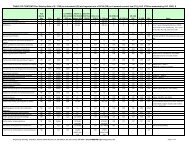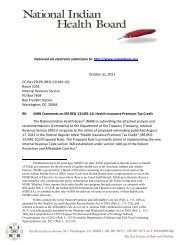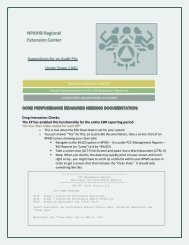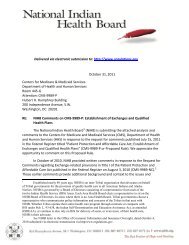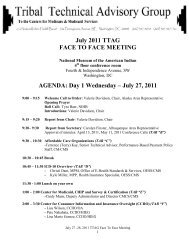mmpc - National Indian Health Board
mmpc - National Indian Health Board
mmpc - National Indian Health Board
You also want an ePaper? Increase the reach of your titles
YUMPU automatically turns print PDFs into web optimized ePapers that Google loves.
Introduction<br />
The <strong>Indian</strong> <strong>Health</strong> Service (IHS) provides only part of the health care needed by the AIAN who rely on the IHS<br />
health care system because of the limited funding appropriated to the agency by the federal budget process.<br />
Funding of the agency has grown in recent years but has not caught up with the growth of the low income AIAN<br />
population, the amount or kinds of specialized care needed, and the increases in health care costs. The IHS<br />
estimates that they provide only 54% of the health care funds needed for the AIAN user population.<br />
The largest and most important alternate resource to IHS for the health care funding of AIAN who rely on the<br />
IHS system is Medicaid. Together with its companion program, the Children’s <strong>Health</strong> Insurance Program (CHIP),<br />
Medicaid has grown to provide a substantial but largely unknown fraction of the coverage of health care for the<br />
AIAN user population of the IHS system. Though the numbers of the user population enrolled in Medicaid and<br />
CHIP has grown substantially over the years, it has been a challenge for IHS and tribally operated health care<br />
facilities accustomed to annual appropriations of federal funds to bill and collect daily claims payments from<br />
state Medicaid programs or private Medicaid managed care plans. Even with Medicaid coverage, it can also be a<br />
challenge for AIAN to obtain the specialty medical care and non-medical services they need from providers<br />
outside the IHS system when they are required.<br />
There has been little reliable data on how much Medicaid funding has grown to cover care the Medicaid enrolled<br />
user population of the IHS system of providers since a household survey of AIAN who rely on the IHS system<br />
was conducted in 1987. While the IHS releases its estimates of total funds gathered from third-parties annually<br />
for the facilities they operate, it is not known how this compares to what is collected at tribally operated<br />
facilities, nor how it breaks down on a per capita basis.<br />
We previously analyzed Medicaid MSIS online data for 2005 on paid claims to IHS system providers on a stateby-state<br />
basis for 2005 (Crouch et al, 2009). That aggregate data could not be used to determine the per capita<br />
funding, or portions of funds spent on IHS system and other providers. The data within states was often from<br />
more than one IHS Area. We then analyzed data extracted from the MSIS data into analytical files for 2004 and<br />
provided estimates of per capita payments for AIAN who had Medicaid (or Medicaid-CHIP) IHS Program claims<br />
in each IHS Area (Crouch et al, 2010). This data could also be compared to per capita payments for AIAN who did<br />
not have such claims and were likely not to have access to the IHS system. It could also be compared to per<br />
capita payments for non-Hispanic Whites living in the same counties. But it could not be determined what the<br />
total number of AIAN Medicaid enrollees who were users of the IHS system. The extent to which there were<br />
AIAN users of the IHS system without Medicaid IHS Program claims paid was an important factor in<br />
determining the potential amounts of funds that IHS system providers might not be collecting.<br />
The data needed to reliably estimate what Medicaid (and Medicaid-CHIP) contribute to cover the health care<br />
costs of AIAN who are users of the IHS system is Medicaid payment data linked to IHS registry data. With such<br />
linked data it is possible to determine how per capita levels of payment for AIAN in the IHS system compare<br />
with those for AIAN not in the system, and to what extent AIAN in the IHS system with Medicaid paid claims do<br />
not have Medicaid IHS Program paid claims. Even more importantly, with Medicaid data linked to IHS registry<br />
data it is possible to determine the fraction of total health care costs of the AIAN user population in the IHS<br />
system is paid by Medicaid and Medicaid-CHIP programs.<br />
1





